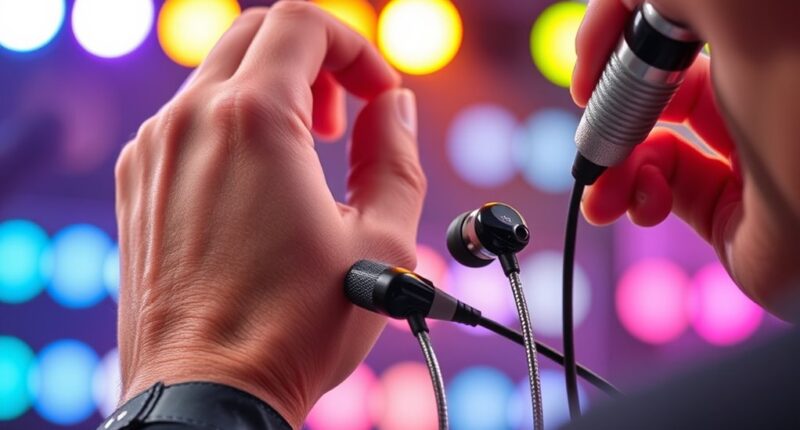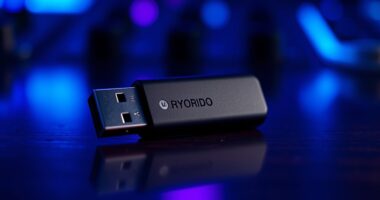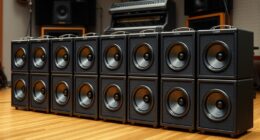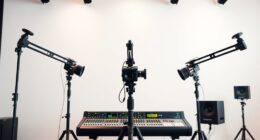If you’re searching for the 15 best in-ear monitor systems that deliver professional sound and reliability, I’ve got you covered. I’ve reviewed top options like the Phenyx Pro, Xvive U4, U45, LEKATO, and multi-receiver setups, all offering low latency, strong signals, and durable build quality. Whether for live gigs, studio work, or rehearsals, these systems stand out. Keep going, and you’ll discover detailed insights to help you find the perfect fit.
Key Takeaways
- The article compares top in-ear monitor systems based on features, audio quality, range, and connectivity for professional performance.
- It highlights systems supporting multiple channels, interference resistance, and low latency for seamless live and studio use.
- Details on build quality, portability, user interface, and power options ensure suitability for touring and stage performances.
- The review covers pros and cons, including signal stability, battery life, and setup complexity for each system.
- It provides insights to help musicians and sound engineers choose reliable, high-performance in-ear monitoring solutions in 2025.
Phenyx Pro Quad-Channel Wireless In-Ear Monitor System
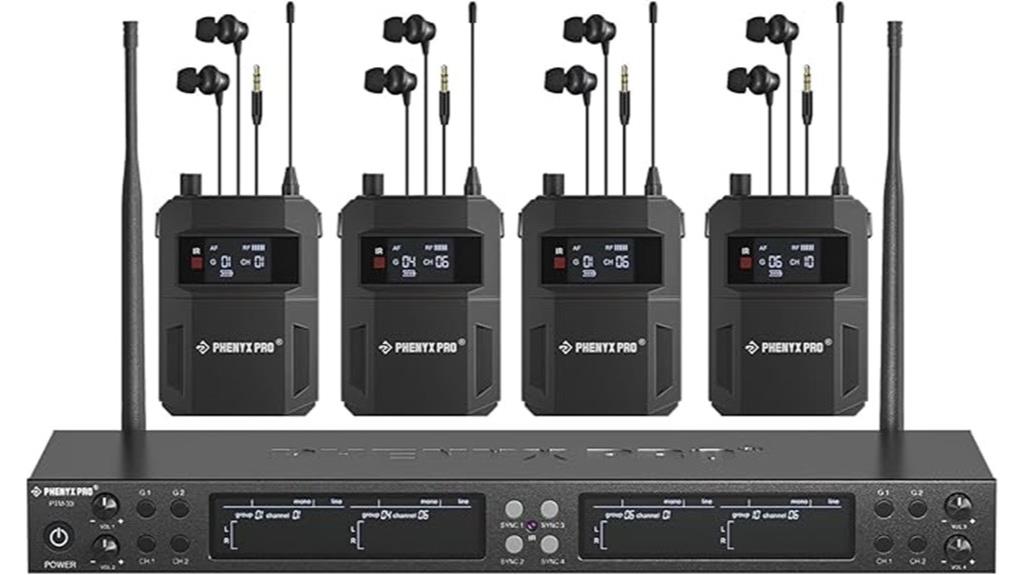
If you’re a professional musician or sound engineer looking for a versatile in-ear monitor system, the Phenyx Pro Quad-Channel Wireless In-Ear Monitor System stands out as a top choice. It features an integrated monitor station with four channels, allowing four groups of inputs and loop outputs, which simplifies setup with just four auxiliary jacks. Its compact 42cm monitor saves rack space and is perfect for touring. Operating on 4×25 UHF frequencies, it provides a clear, interference-free range of up to 164 feet. With four standalone mixes and quick IR sync technology, it delivers reliable, high-quality audio for live performances and studio use.
Best For: professional musicians, sound engineers, and performers seeking reliable, versatile in-ear monitoring for live stage performances or studio work.
Pros:
- Offers four independent channels for personalized monitoring setups
- Operates on 4×25 UHF frequencies, ensuring interference-free audio transmission up to 164 feet
- Compact design with rack-mount accessories saves space and facilitates touring flexibility
Cons:
- May require initial setup and syncing with multiple receivers for optimal performance
- Limited to four channels, which might not be sufficient for very large groups or complex setups
- Dependence on batteries (8 AA included) could lead to additional costs or power management considerations
Xvive U4 Wireless In-Ear Monitor System
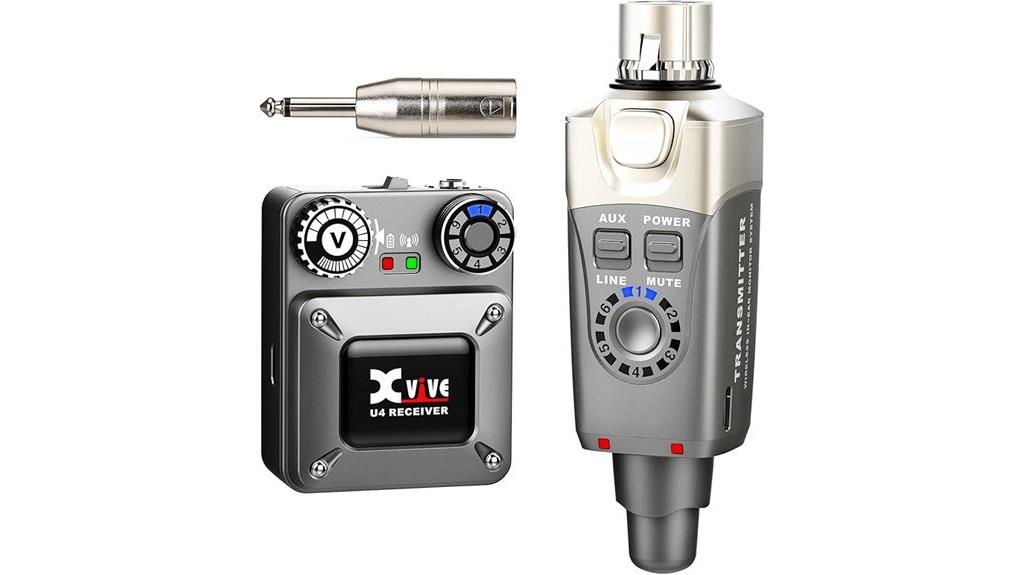
The Xvive U4 Wireless In-Ear Monitor System stands out as an excellent choice for musicians and performers who need reliable, high-quality wireless monitoring without breaking the bank. Its compact, durable metal housing and 2.4GHz operation deliver uncompressed audio with low noise and under 5ms latency, ensuring real-time monitoring. Easy to set up, it supports up to 8 channels, offering interference management and a broad frequency response of 20Hz-20kHz. With crisp treble, tight bass, and around 5 hours of rechargeable power, it combines professional sound quality with user-friendly features, making it a versatile, cost-effective solution for stage and studio performances.
Best For: musicians, performers, and sound engineers seeking reliable, high-quality wireless in-ear monitoring on stage or in the studio.
Pros:
- Compact, durable metal housing with professional-grade audio transmission
- Supports up to 8 channels with interference management and broad 20Hz-20kHz frequency response
- Easy plug-and-play setup with stable connection and low latency (less than 5ms)
Cons:
- Slight interference reported at lower volumes due to 2.4GHz frequency in some environments
- Includes an unbalanced XLR/1/4 adapter which may be unnecessary for some users
- Battery life of around 5 hours may require additional charging or extra batteries for extended use
Xvive U45 Wireless In-Ear Monitor System

The Xvive U45 Wireless In-Ear Monitor System stands out for its reliable 5.8 GHz operation with true diversity technology, making it an excellent choice for performers who need a stable wireless connection across stages or studios. It reliably transmits signals up to 100 feet, minimizing interference and ensuring consistent audio. The system features a handy channel scan mode, allowing quick optimization for the best signal. With a broad frequency response of 20Hz to 20kHz and 24-bit/48kHz audio quality, it delivers clear, detailed sound. Plus, its USB-C charging keeps the system powered for up to five hours, making it a versatile and dependable option.
Best For: performers, musicians, and audio professionals seeking a reliable, high-quality wireless in-ear monitoring system for live performances, rehearsals, or studio use.
Pros:
- Operates at 5.8 GHz with true diversity technology for a stable RF connection up to 100 feet
- High-resolution 24-bit/48kHz audio with a broad 20Hz–20kHz frequency response for clear sound
- Quick channel scan mode simplifies finding the optimal wireless channel
Cons:
- Battery life may be limited to around 5 hours, which might require additional power management for extended use
- USB-C charging may not be compatible with all existing chargers or power sources without adapters
- The system’s range and interference resistance, while solid, could vary in highly congested wireless environments
LEKATO Wireless In-Ear Monitor System MS-02
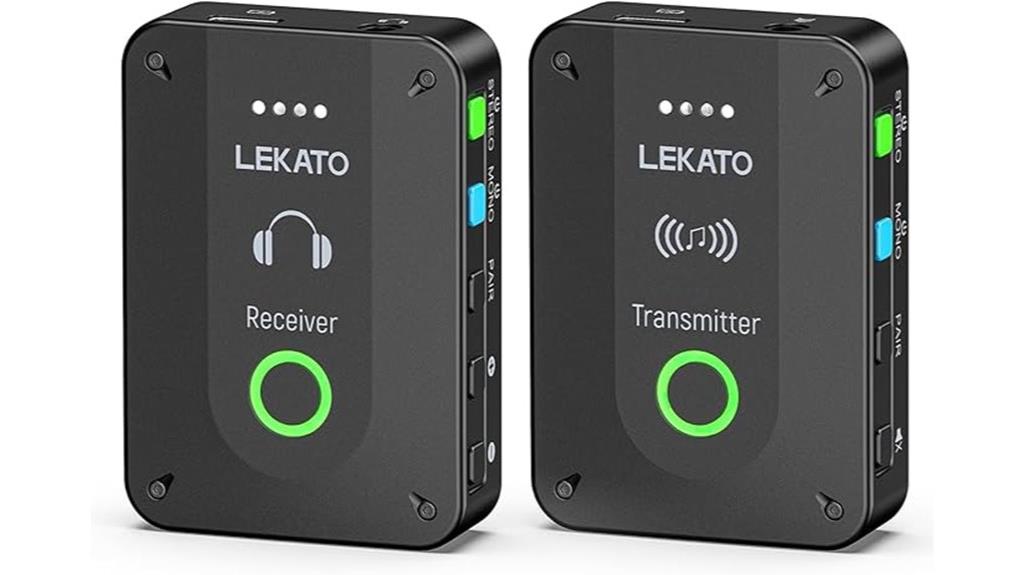
For musicians and performers seeking an affordable yet reliable in-ear monitoring solution, the LEKATO Wireless In-Ear Monitor System MS-02 stands out with its upgraded 2.4GHz wireless technology and compact design. Weighing just 5.3 ounces, it offers a lightweight, clip-on setup that’s easy to carry and quick to set up. The system supports mono and stereo modes with a simple one-key switch, and the receiver has volume controls. With ultra-low latency under 4.5ms, a range of 100 feet, and up to 8 hours of battery life, it delivers clear, high-fidelity sound ideal for live performances, rehearsals, or studio use—all at an accessible price point.
Best For: musicians, performers, and audio enthusiasts seeking an affordable, portable, and reliable in-ear monitor system for live performances, rehearsals, and studio use.
Pros:
- Ultra-low latency (<4.5ms) ensures minimal audio delay during performances
- Lightweight and portable design (5.3 ounces) with easy clip-on setup
- Supports multiple receivers simultaneously, ideal for band setups or group monitoring
Cons:
- Not water-resistant, which may affect outdoor or humid use
- Some users experience intermittent latency or higher delays after silence periods
- Touch controls can be sensitive or accidental during active performances
8 Bodypacks Wireless In-Ear Monitor System for Stage and Studio
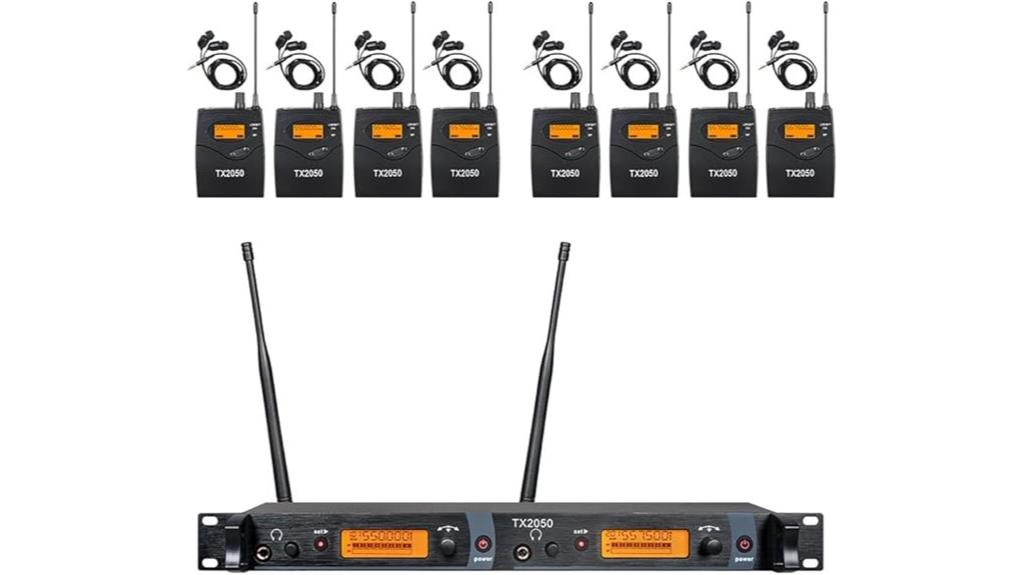
If you need reliable, high-quality in-ear monitoring for stage and studio performances, the Bodypacks Wireless In-Ear Monitor System stands out as a top choice. Its durable brushed metal build guarantees longevity, while the centralized LCD display and dual-side operation buttons make setup simple. With over 300 feet of stable range and dual-antenna digital processing, you get clear, high-fidelity sound with minimal interference. The system’s advanced digital technology resists frequency drops, and built-in limiter circuitry prevents distortion. Plus, the front 1/4-inch headphone jack lets you monitor directly. It’s perfect for live gigs, studio work, or any environment demanding flexible, dependable in-ear monitoring.
Best For: performers, musicians, and sound engineers seeking reliable, high-quality in-ear monitoring for stage and studio environments.
Pros:
- Durable brushed metal construction ensures long-lasting use
- Over 300 feet of stable, clear audio transmission with minimal interference
- User-friendly setup with centralized LCD display and dual operation buttons
Cons:
- Receiver requires two AA batteries, which are not included
- Limited to 40 preset channels, potentially requiring manual switching in crowded RF environments
- May be more expensive compared to basic wired monitoring systems
Wireless In-Ear Monitor System with 4 UHF Bodypack Receivers
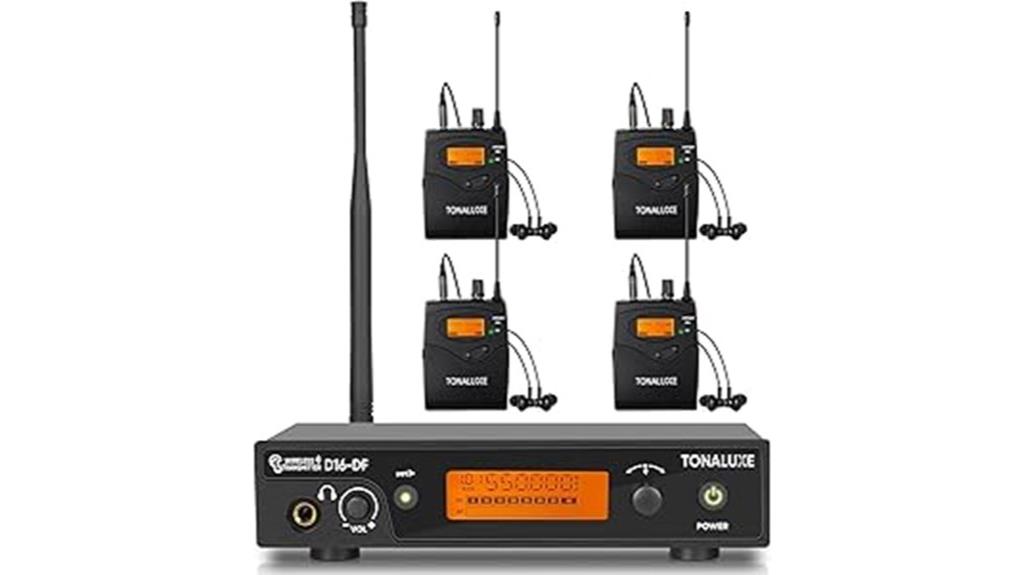
A wireless in-ear monitor system with four UHF bodypack receivers is an excellent choice for performers or sound engineers who need reliable, high-quality monitoring across large stages. Operating between 550–579.25 MHz with 100 selectable channels, it ensures interference-free communication. The system supports up to 262 feet (80 meters) in open areas, providing ample freedom of movement. It features premium stereo monitors for vibrant sound, with stereo and mono modes for personalized mixes. The rugged transmitter offers multiple inputs, automatic pairing, and RF signal indicators. Each lightweight receiver displays real-time status and includes earphones, making setup and operation straightforward for professional-stage use.
Best For: performers, musicians, and sound engineers seeking a reliable, high-quality wireless in-ear monitoring system suitable for large stage environments.
Pros:
- Operates across 550–579.25 MHz with 100 selectable channels for flexible, interference-free operation
- Supports up to 262 feet (80 meters) range in open areas, allowing extensive mobility on stage
- Includes premium stereo monitors and multiple monitoring modes for personalized, clear sound
Cons:
- Requires two AA batteries per receiver, which need regular replacement or recharging
- Setup may be complex for first-time users without prior experience with wireless systems
- Limited to UHF frequency range, which may require careful channel selection to avoid interference in crowded RF environments
Wireless In-Ear Monitor System with 2 Bodypacks (IME-8000)
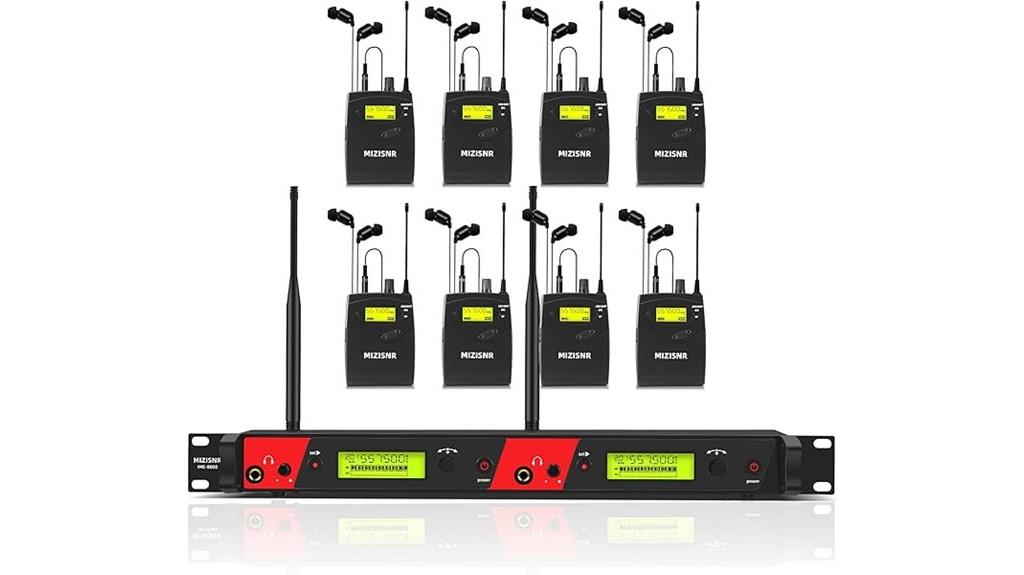
The Wireless In-Ear Monitor System with 2 Bodypacks (IME-8000) stands out as an ideal choice for performers and sound engineers who need reliable, high-quality wireless monitoring on stage or in the studio. Operating on UHF with PLL technology, it prevents interference and drops, ensuring stable signals up to 330 feet. Its built-in limiter guarantees distortion-free sound with zero latency. The system’s durable transmitter, lightweight receivers, and IR sync make setup quick and straightforward. Users praise its clear audio, minimal feedback, and long-range coverage, though some note occasional static or channel issues. Overall, it offers impressive value for professional-grade wireless in-ear monitoring.
Best For: performers, sound engineers, and musicians seeking reliable, high-quality wireless in-ear monitoring for stage or studio use.
Pros:
- Stable wireless connection with up to 330 feet range and minimal interference
- Clear, high-fidelity sound with built-in limiter and zero latency
- Easy setup with IR sync, durable transmitter, and lightweight receivers
Cons:
- Some users experience static, channel finding issues, or dropped receivers
- Fragile receivers may break if dropped or mishandled
- Limited setup instructions and missing international plug adapters for overseas users
Xvive U4 Wireless in-Ear Monitor System Set
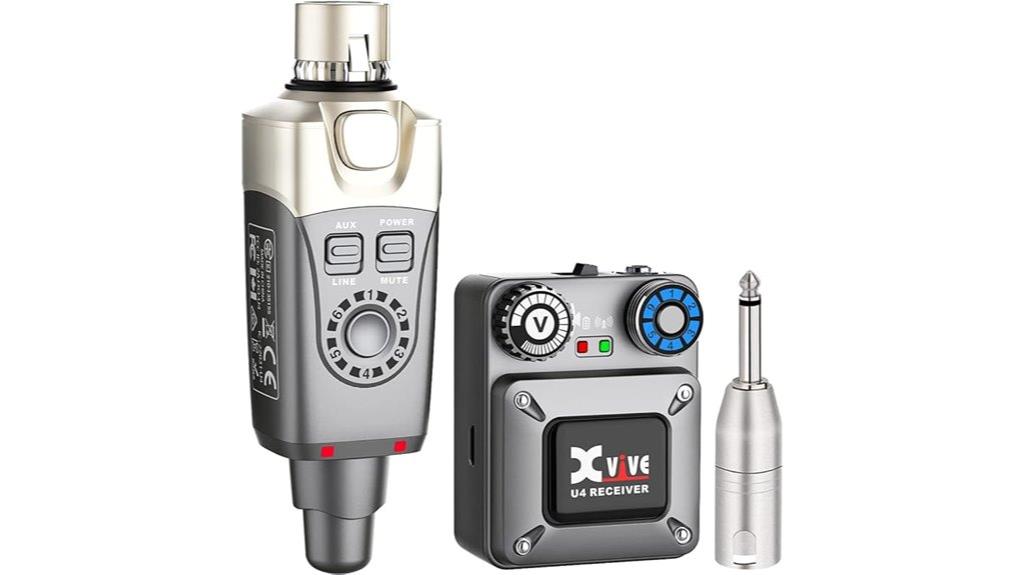
Traversing stages and ensuring clear, reliable audio is essential for performers, and the Xvive U4 Wireless in-Ear Monitor System Set delivers with its robust 2.4GHz wireless technology. It offers seamless connectivity across various venues, with a working range of over 90 feet, perfect for small clubs and stage performances. Supporting six channels, it minimizes interference and supports multiple performers simultaneously. The system boasts less than 5ms latency, ensuring real-time, distraction-free monitoring. Rechargeable batteries deliver up to five hours of continuous use, and the package includes everything needed—receivers, transmitter, adapters, and a carrying bag—making setup and transport effortless.
Best For: musicians, performers, and stage crews seeking reliable, wireless in-ear monitoring solutions for live performances across various venues.
Pros:
- Reliable 2.4GHz wireless technology with over 90 feet range ensures stable connectivity.
- Supports 6 channels for multiple users and minimal interference during performances.
- Less than 5ms latency provides real-time, distraction-free audio monitoring.
Cons:
- Battery life of up to 5 hours may require frequent recharging during extended gigs.
- May be limited in environments with high Wi-Fi congestion or interference.
- Includes only essential accessories; additional adapters or mounts may be needed for specific setups.
LEKATO Wireless In-Ear Monitor System (MS-1)

For musicians and performers seeking a reliable, easy-to-use wireless in-ear monitoring solution, the LEKATO MS-1 stands out with its support for multiple receivers—up to six—on a single transmitter. Its auto-pairing feature makes setup quick and hassle-free—just turn on, press PAIR, and wait for the green light. The system offers stereo and mono modes with a one-key switch, ensuring true stereo sound when needed. Operating on the 2.4GHz band, it provides lossless audio with low latency, a range of 90 feet, and over 5 hours of rechargeable battery life. Compact and versatile, it’s perfect for gigs, rehearsals, and studio use.
Best For: musicians, performers, and small to medium-sized bands seeking a reliable, easy-to-setup wireless in-ear monitoring system for live performances, rehearsals, or studio use.
Pros:
- Supports up to six receivers simultaneously, ideal for group performances.
- Auto-pairing feature simplifies setup and reduces setup time.
- Offers true stereo sound with a one-key switch, ensuring high audio fidelity.
Cons:
- Limited to a 90-foot range, which may be restrictive for very large venues.
- Battery life of over 5 hours might require additional power management for extended gigs.
- Designed primarily for small to medium settings; may lack advanced features needed for larger productions.
IEM UHF Wireless In-Ear Monitor System with 8 Bodypacks
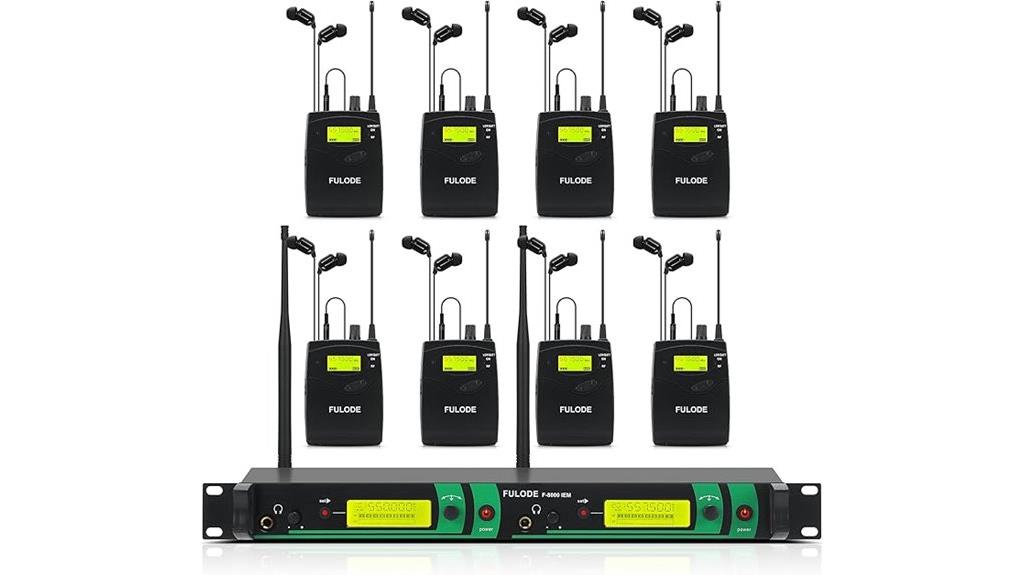
If you need a reliable in-ear monitoring system capable of supporting multiple performers simultaneously, the IEM UHF Wireless In-Ear Monitor System with 8 bodypacks is an excellent choice. It offers two channels with eight bodypacks, supporting stage, studio, and church setups. With 40 UHF frequencies and a range of up to 330 feet, it guarantees stable, clear audio even in large or complex environments. The system features advanced transmission tech, anti-interference, and built-in limiters for distortion prevention. Its durable metal housing and easy setup make it ideal for live performances, providing high-quality sound and versatile use across various professional and hobbyist applications.
Best For: musicians, performers, or audio professionals seeking a reliable, multi-user wireless in-ear monitoring system for live stage, studio, or church settings.
Pros:
- Supports up to 8 bodypacks across 2 channels, ideal for multiple performers simultaneously
- Wide frequency range with 40 UHF channels and a range of up to 330 feet for versatile performance environments
- Durable metal housing and advanced transmission tech ensure stable, high-quality audio with minimal interference
Cons:
- Range limitations may cause signal dropouts or crackling beyond close proximity to the transmitter
- Batteries are not included, requiring additional purchase of rechargeable AA batteries for extended use
- Not water-resistant, so it may not withstand outdoor or harsh weather conditions
Xvive U45 Wireless In-Ear Monitor System
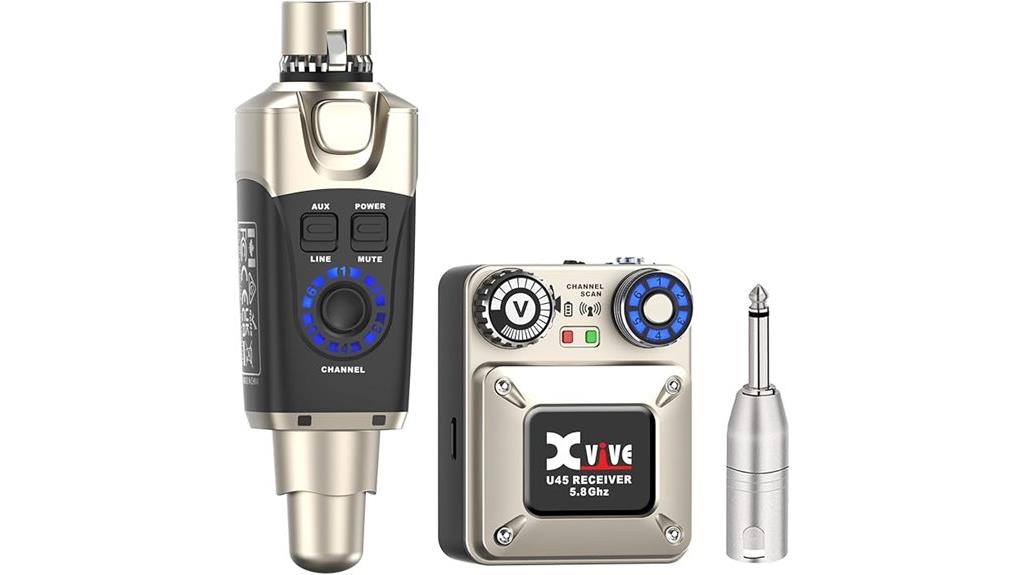
The Xvive U45 Wireless In-Ear Monitor System stands out for performers who need a reliable, high-quality wireless solution that minimizes latency and interference. Operating on 5.8GHz, it offers enhanced stability and clear sound, thanks to its auto channel scan that automatically selects the best channel. With less than 5ms latency, it supports seamless in-ear monitoring during live performances. Its impressive range of up to 100 feet allows freedom of movement without signal loss. Both transmitter and receiver feature rechargeable batteries, providing up to 5 hours of continuous use. It’s a compact, user-friendly system perfect for musicians seeking dependable wireless performance.
Best For: performers and musicians seeking a reliable, high-quality wireless in-ear monitoring system with minimal latency and interference.
Pros:
- Operates on 5.8GHz for enhanced stability and reduced interference
- Less than 5ms latency ensures near-instantaneous audio transmission
- Up to 100ft wireless range allows for maximum freedom of movement
Cons:
- Battery life of up to 5 hours may require frequent recharging during long performances
- Limited package contents may necessitate additional accessories for full setup
- Potential cost may be higher compared to wired monitoring options
Wireless In-Ear Monitor System with Transmitter and Bodypack Receiver
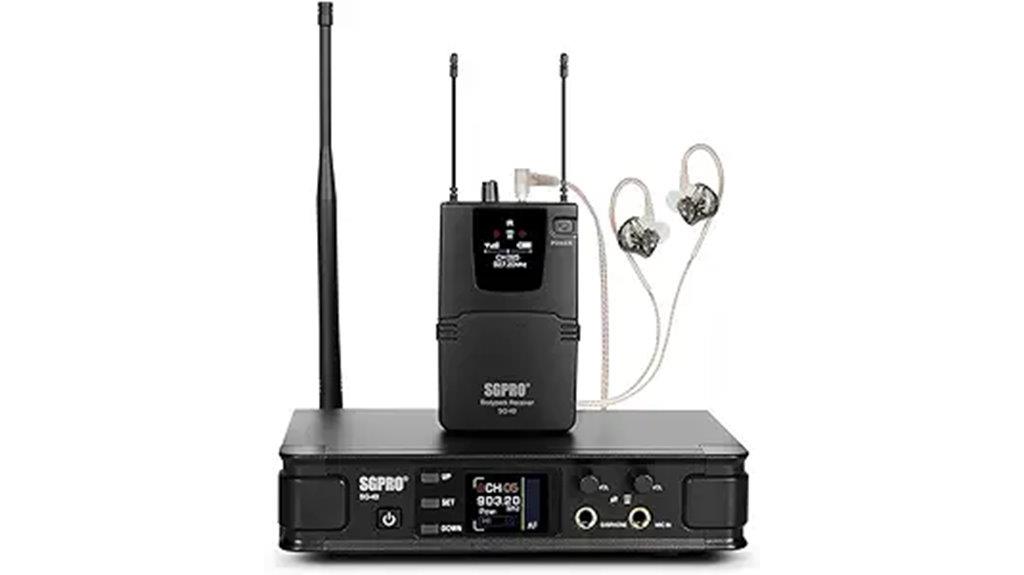
A wireless in-ear monitor system with a transmitter and bodypack receiver is ideal for performers and sound engineers seeking reliable, interference-free audio during live performances or studio sessions. Operating in the UHF band with 85 adjustable frequencies, it guarantees crystal-clear sound and minimizes dropouts, thanks to enhanced antenna diversity. The compact, rugged design includes a half-19-inch rack transmitter supporting up to 100 meters coverage, multiple audio inputs, and touch controls for easy operation. With a 6-hour battery life and active noise cancellation, it delivers deep bass and clear monitoring. Overall, it’s a versatile, professional-grade system that balances affordability with solid performance, suitable for a range of live and studio applications.
Best For: performers, sound engineers, and event organizers seeking reliable, interference-free in-ear monitoring for live performances or studio use.
Pros:
- Crystal-clear, stable audio with interference-free UHF transmission and enhanced antenna diversity.
- Versatile setup with multiple audio inputs (XLR, 1/4″, phantom power support) and support for multiple receivers.
- Compact, durable design with long 6-hour battery life and easy-to-use touch controls.
Cons:
- Limited volume and headroom may not meet the needs of very demanding professional applications.
- Some users have reported initial power issues and potential durability concerns with the main power unit.
- Water resistance level not specified, which could be a concern in certain environments.
Phenyx Pro UHF Mono Wireless In-Ear Monitor System
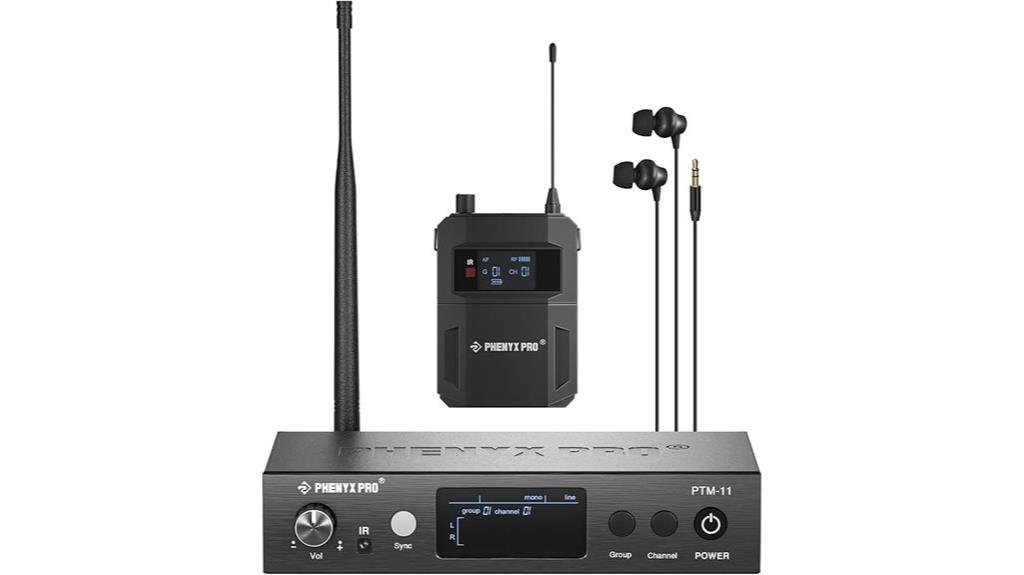
Looking for a reliable in-ear monitor system that delivers crisp mono audio with minimal setup? The Phenyx Pro UHF Mono Wireless In-Ear Monitor System (PTM-11) fits the bill perfectly. It offers stable UHF 900MHz performance with 50 selectable frequencies, supporting up to five simultaneous systems. Its mono design eliminates phase issues, ensuring focused sound and clear monitoring. Setup is straightforward, with separate outputs for personal mix and a built-in PAD switch to prevent distortion. Durable and portable, this system is ideal for stage performers, broadcasters, and studio use, providing professional-grade sound quality and seamless mobility in a compact package.
Best For: stage performers, church pastors, broadcasters, and studio professionals seeking reliable, professional-grade mono in-ear monitoring with minimal setup and excellent sound clarity.
Pros:
- Stable UHF 900MHz performance with 50 selectable frequencies supports multiple systems simultaneously
- Mono design eliminates phase issues, providing focused and clear audio monitoring
- Compact, durable, and portable with easy setup and separate outputs for personal mix
Cons:
- Performance may be affected by thick walls, glass, or metal barriers which can interfere with signal stability
- Limited to mono audio, which may not suit users requiring stereo sound monitoring
- Requires careful frequency management to avoid interference when multiple systems are used simultaneously
Wireless In-Ear Monitor System, 2.4G Stereo Wireless IEM with Beltpack Transmitter & Receiver
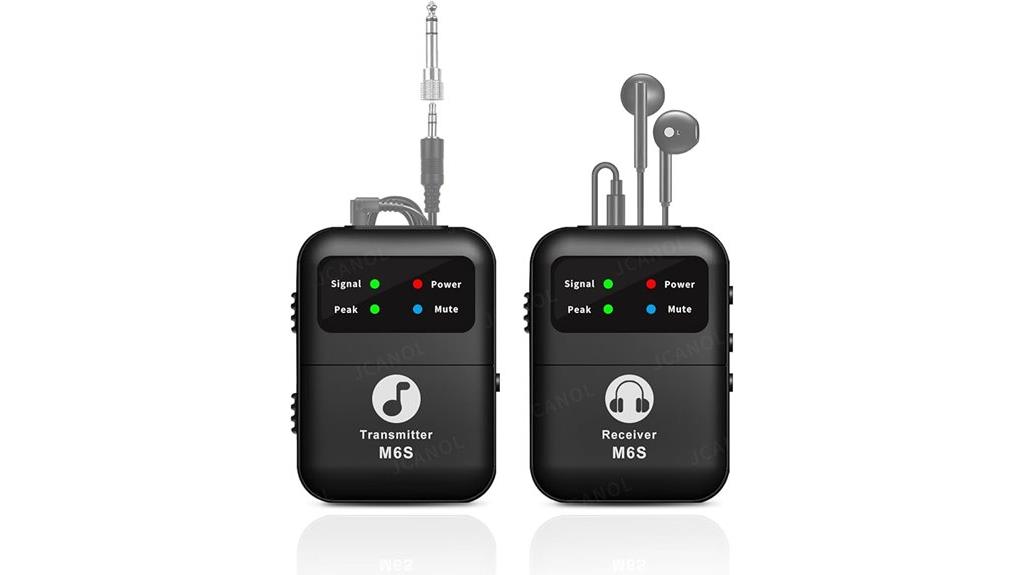
Are you searching for a reliable wireless monitor system that guarantees crystal-clear sound and seamless mobility on stage? The Wireless In-Ear Monitor System, 2.4G Stereo Wireless IEM, with its beltpack transmitter and receiver, delivers just that. Operating on a 2.4GHz frequency with a 164-foot range, it ensures stable signal quality with minimal latency (less than 5 ms) and no feedback. Its automatic pairing, mono/stereo switching, and compatibility with various headphones make setup quick and simple. With support for up to 10 channels and Hi-Fi audio quality, this lightweight system is perfect for live performances, rehearsals, and studio use.
Best For: live performers, musicians, and audio professionals seeking reliable, high-quality wireless in-ear monitoring with easy setup and minimal latency.
Pros:
- Stable 2.4GHz connection with up to 164 ft. range ensures reliable signal during performances
- Automatic pairing and intuitive controls for quick, hassle-free setup and operation
- High-fidelity audio with less than 5 ms latency and broad frequency response (20Hz-20KHz) for professional sound clarity
Cons:
- Only compatible with devices featuring 3.5mm or 6.35mm audio jacks; may require adapters for some equipment
- Made of plastic; may feel less durable compared to metal-bodied systems
- Limited to adult users due to size and design; not specifically tailored for children
Phenyx Pro UHF Wireless In-Ear Monitor System

The Phenyx Pro UHF Wireless In-Ear Monitor System stands out for its reliable UHF frequency range and tunable channels, making it an excellent choice for performers and sound engineers working in crowded or outdoor environments. Operating in the 900MHz band, it reduces interference and dropouts, with 89 selectable frequencies supporting up to five systems simultaneously. Its transmission range reaches up to 160 feet, providing stable, real-time audio without latency issues common in 2.4GHz setups. With true stereo and mono modes, clear sound quality, and practical features like EQ, limiter, and remote control, it’s a versatile, durable system suited for professional and amateur use alike.
Best For: performers, sound engineers, and enthusiasts seeking a reliable, interference-resistant wireless in-ear monitoring system suitable for live stage, outdoor, or crowded environments.
Pros:
- Utilizes less congested 900MHz UHF band for stable, interference-free transmission
- Supports up to 5 systems simultaneously with tunable 89 frequencies
- Offers clear stereo/mono modes with excellent sound quality and practical control features
Cons:
- Plastic bodypack and simple design may feel less durable to some users
- Flimsy antennae, though reinforced, can be fragile and may require careful handling
- Not water-resistant, limiting use in wet or outdoor conditions
Factors to Consider When Choosing In‑Ear Monitor Systems
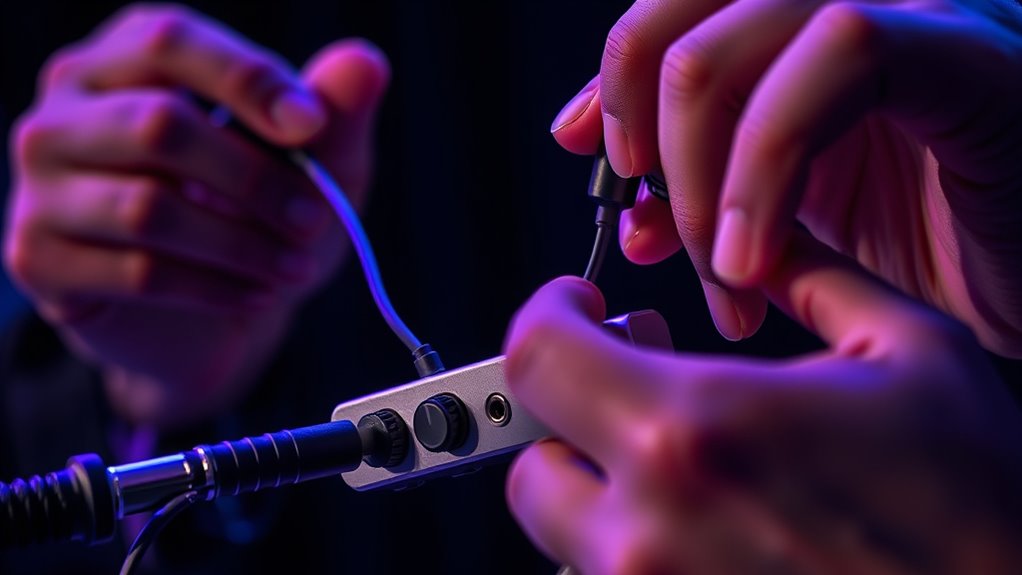
When selecting an in-ear monitor system, I focus on factors like wireless frequency stability and audio clarity to guarantee reliable performance. Battery life and device compatibility also matter, so I can use them confidently during long gigs. Additionally, signal range flexibility helps me move freely without losing connection.
Wireless Frequency Stability
Stable wireless frequency is essential for in-ear monitor systems because it guarantees a reliable connection and consistent audio quality during live performances. When the frequency drifts or faces interference, signal dropouts and audio interruptions occur, disrupting the performance. Choosing systems that operate on less congested bands like UHF or 5.8GHz helps reduce interference from other wireless devices, ensuring better stability. A system’s ability to lock onto a specific channel and maintain it is crucial for consistent sound. Features like multiple preset channels and automatic scanning allow rapid adaptation to the best available frequency, enhancing reliability. Environmental factors such as walls, metal objects, or electronic interference can impact frequency stability, so opting for a system with strong interference resistance is essential for seamless performance.
Audio Quality Clarity
Choosing an in-ear monitor system with excellent audio quality hinges on several key factors. A broad frequency response, from 20Hz to 20kHz, ensures I hear the full spectrum of sound, capturing every detail clearly. A high signal-to-noise ratio, often above 100dB, minimizes background noise, making vocals and instruments stand out sharply. Low total harmonic distortion and latency under 5ms are essential for maintaining true audio fidelity and synchronization during performances. Digital systems supporting 24-bit/48kHz audio provide higher resolution, delivering more nuanced sound. Additionally, proper frequency management and interference resistance prevent dropouts and unwanted noise, guaranteeing consistent clarity. Together, these factors help me choose a system that reproduces sound faithfully, ensuring I perform confidently with professional-grade audio quality.
Battery Life Duration
Battery life is a critical factor that directly impacts my performance, especially during long rehearsals and gigs. I need my in-ear monitors to last without constant recharging, so I can stay focused on my performance. Most wireless systems offer between 4 to 8 hours of battery life per charge, depending on the model and features used. Rechargeable batteries are common, which makes swapping or recharging between sets quick and easy, minimizing downtime. However, battery life can be affected by factors like signal strength, volume levels, and features such as Bluetooth or noise cancellation. Many systems come with low-battery indicators, helping me avoid unexpected power loss and plan recharges accordingly. Reliable battery life ensures I stay powered throughout my performance without disruptions.
Compatibility With Devices
When selecting an in-ear monitor system, it’s important to guarantee it works seamlessly with my existing audio gear. I check that it’s compatible with my mixers, interfaces, or wireless transmitters, ensuring the right input/output connections like XLR, 1/4-inch, or TRS jacks. I also verify if the system supports the necessary audio formats, whether mono or stereo, to match my monitoring needs. Compatibility with wireless frequency bands, such as UHF, 2.4GHz, or 5.8GHz, is vital to avoid interference in my venue. I confirm that the receiver units can connect easily with my headphones or IEMs, paying attention to connector types and impedance. Finally, I consider if the system’s control features, like auto-pairing or remote adjustments, align with my operational preferences and existing equipment.
Signal Range Flexibility
The signal range of an in-ear monitor system directly impacts how freely I can move on stage without worrying about dropouts. Longer ranges, often over 300 feet, give me more freedom to roam, especially with UHF systems that offer more stable signals over distance. Shorter ranges, like 90 feet, limit mobility but can suffice for smaller setups. Obstacles such as walls, metal, or thick glass can cut down this range, making it essential to choose systems with adjustable or multiple channels to avoid interference. A greater signal range ensures performers can move naturally without latency or signal loss, which is vital during dynamic performances. Picking a system with the right range for my stage environment keeps my performance seamless and distraction-free.
Frequently Asked Questions
How Do In-Ear Monitor Systems Affect Stage Sound Isolation?
In-ear monitor systems markedly improve stage sound isolation by sealing my ears with custom or universal earpieces. This blocks out ambient noise, allowing me to focus on the mix and perform confidently. I notice less stage bleed, which means I hear only what I need without external distractions. Overall, they create a cleaner, more controlled listening environment, helping me stay in sync and deliver my best performance.
What Are the Best Battery Life Options for Touring Performances?
For touring performances, I prioritize batteries with long life and quick recharge times. I usually go for lithium-ion packs because they last all day, often 8 to 12 hours, and recharge quickly, sometimes in under an hour. I also carry spare batteries to guarantee I never run out mid-set. Investing in high-capacity, reliable batteries helps me stay focused on my performance without worrying about power issues.
Can I Customize In-Ear Monitor Mixes for Different Performers?
They say “variety is the spice of life,” and that’s true for in-ear monitor mixes. Yes, you can customize mixes for different performers. I use digital systems that let each artist adjust their own sound, ensuring everyone hears what they need. It’s like having a personalized audio experience for each person on stage. Custom mixes improve performance, confidence, and overall sound quality—making the show truly seamless.
How Do Wireless Frequencies Impact Signal Stability in Crowded Venues?
Wireless frequencies critically impact signal stability in crowded venues. I’ve found that higher frequencies, like 2.4 GHz, tend to be more crowded and prone to interference, causing dropouts. Using lower frequencies, such as 5 GHz or dedicated UHF bands, can improve stability because they’re less congested. However, it’s essential to scan the venue beforehand and choose frequencies with the least interference to guarantee reliable, clear audio for performers.
What Maintenance Tips Prolong the Lifespan of Wireless In-Ear Systems?
Think of your wireless in-ear system as a garden that needs tending. I regularly clean the earbuds and charging contacts, keep firmware updated, and store it in a cool, dry place. I also avoid exposing it to extreme temperatures and moisture. These simple acts prevent corrosion and hardware issues, helping my system perform reliably over time, just like a well-tended garden flourishes and stays healthy.
Conclusion
If you’re serious about sounding like a pro on stage, these IEM systems are game-changers. They deliver crystal-clear audio with the precision of a master engineer’s touch—making every note feel like a thunderous masterpiece. Whether you’re a seasoned performer or just starting out, choosing the right system can elevate your performance to legendary status. Trust me, once you experience these, you’ll wonder how you ever performed without them—your ears will thank you!
